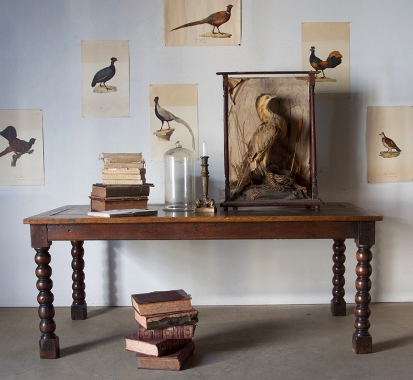The Domestic Museum
The Domestic Museum
I like to think that a fascination with objects discarded by time is a common, perhaps innate human trait. A curiosity incubated in childhood that remains potent as an adult and is kindled daily by the enduring mystery of the world we awake to each morning. As far back as the sixteenth century, collectors were amassing personal inventories of natural specimens and antiquities - the collections were used to entertain, educate and delight, they were the precursors to the modern museum. My own enthusiasm for collecting was undoubtedly fuelled by my museum mad mother.
My most distant memories include stories of the museum that my mother created as a child in a shed at the bottom of her garden. Aided and abetted by her adoring father and to the horror of her very tidy, house proud mother, she collated an extraordinary array of exhibits gleaned from the garden, the neighbourhood and further afield. One day she found a dead kingfisher on the corner of her road. She scooped the bird up and carried it home with its soft, iridescent feathers fluttering jewel like in her small hands. Lacking the taxidermy wherewithal to include the bird in her own museum she decided to deliver it to the Canterbury Museum who gratefully added it to their collection. That single gift opened the door to the museum workshops, where she soon became a regular helper—eventually painting display backdrops and assisting behind the scenes.
She was joined by her lifelong friend Judy who serendipitously arrived in Mum’s life via an inter school spelling bee where they met, shared the winning prize and made the delightful discovery that they each had a museum in their garden sheds. Mum and Judy took their respective museum curatorship very seriously - everything was researched and catalogued in a detailed inventory and arranged for display in the appropriate category in their shed museums and throughout their teenage years the pair continued to help out at the Canterbury museum. Inevitably, my sisters and I absorbed Mum’s museum fervour as if by osmosis, as she fizzed about the natural world and found any excuse for a museum visit. I recall many grey and cloudy afternoons trailing her around the vaulted, echo laden chambers of the museum - marveling at the immense size of an albatross and the complexity of a Victorian corset. Our imaginations would delve into drawers filled with beetles as beyond the walls of the museum Christchurch was enveloped in its habitual suburban gloom.
My childhood bedroom was an amateur cabinet de curiosités: stones, bones, cicadas and desiccated frogs trailed along the windowsill. I built dioramas in cardboard boxes - undersea worlds populated by fish and seaweed and pastoral scenes resplendent with butterflies. Flowers and leaves were pressed between the pages of weighty books and in the autumn I gathered mushrooms and toadstools to meticulously illustrate and create my own personal compendium of fungi à la Beatrix Potter. I had a rucksack and a specialised mushroom gathering knife and was convinced that some day I might become a celebrated mycologist. Family walks involved filling our pockets with seed pods, shells and lichen while our mother recited the names of plants in Latin as we passed by. The landscape teemed with possibility, detail and wonder.
Decades later, a year spent in Paris included visits to countless museums, large and small - obscure 18th century maisons de maître, still furnished with their original owner’s idiosyncratic collections, Malmaison - the home of the empress Josephine with its Empire quirks and splendour, the Musée de Cluny filled with treasures from the Middle Ages and the ossified glory of the beautiful, Art Nouveau, Galerie de Paléontologie et d'Anatomie Comparée. I was feverish with excitement when we finally visited the home of the esteemed French entomologist Jean-Henri Fabre in the South of France. His study was thick with dust and crammed with natural history books, insects and microscopes - each object was gilded by the late afternoon, Provençal sunlight. A moment of time strangely entombed, as if the man himself had just stepped out of the room.
Time and age have not dimmed my mother’s fascination with the natural world - even today she sends me frequent photos of flowers, birds, plants and insects: just the other day a crowd of pale basket fungus glowing eerily in the thin, wintry light. I sometimes think that Haunt may be an unconscious expression of my museum infused background which cultivated the need to gather and protect rarefied things, to surround myself with beauty and to always be reminded of the wonder of this world … and I am ever grateful to my extraordinary mother who diligently continues to remind me.
This beautiful, eighteenth-century, French, museum reading table embodies the spirit of the collector - crafted from centuries-old oak, its history is etched into the depths of its patina. The perfect dimensions for a practical and richly characterful dining table.
To view the original newsletter please follow the link : https://mailchi.mp/86ca1a3e0022/the-domestic-museum

